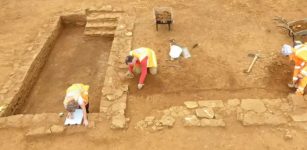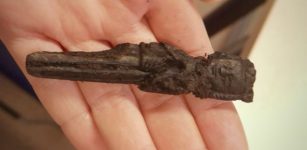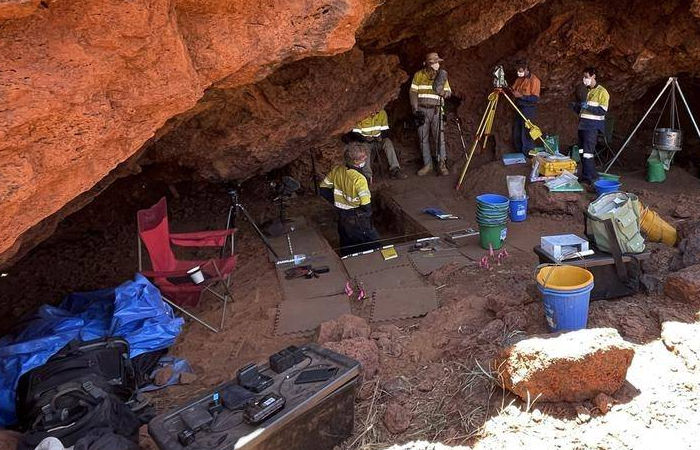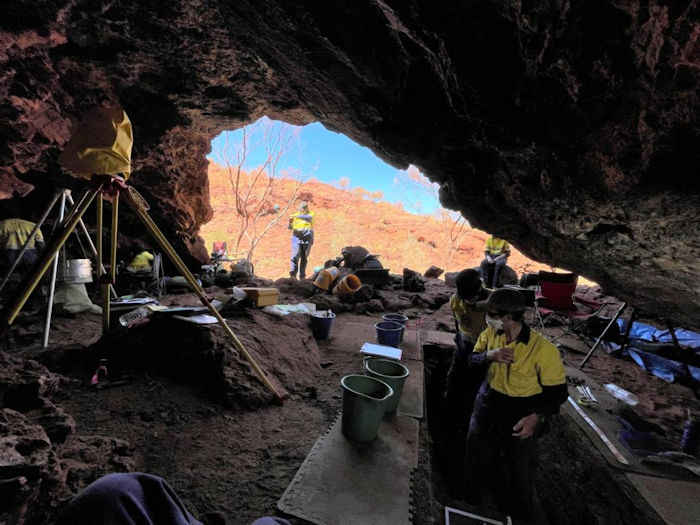Artifacts Discovered At Yirra Confirm Aboriginal People Lived In Pilbara During The Last Ice Age
Conny Waters - AncientPages.com - Archaeological excavation on a sacred site in the Pilbara has found proof Aboriginal people lived in the region during the last Ice Age.
Scientists have analyzed stone tools, charcoal, and bone collected from the Yirra rock shelter at Rio Tinto's Eastern Channar mine. The study results confirm the Yinhawangka people's ties to the land.
Artifacts collected at a Pilbara rock shelter show Aboriginal presence for over 50,000 years. Credit: Archae-aus
It is evident Aboriginal people lived in the eastern Pilbara region for more than 50,000 years, including throughout the height of the last Ice Age.
"The Yinhawangka Aboriginal Corporation commissioned the excavation project of the Yirra rock shelter at Rio Tinto's Eastern Channar mine about 17km southeast of Paraburdoo.
The project was led by YAC in collaboration with Archae-aus heritage consultants, and researchers from the University of Western Australia and had funding from Rio Tinto.
YAC chairperson Halloway Smirke said Yirra has great significance not only to the Yinhawangka people, but also to the Wangarada and Ngarngarada.
"We hope that Yirra will help us tell our ancestral story to Australia and our future generations," he said.
"We would still be visiting this site if it wasn't for the mining leases.
"All Pilbara groups should have this kind of science work done on cultural sites. Important sites like Yirra need to be protected, especially when they turn out to be amongst the oldest known places of human habitation in Australia."
Initial dating results indicate it is one of the oldest sites found in Australia, with Yirra providing proof of Aboriginal occupation in the region for more than 50,000 years and throughout the height of the last Ice Age," the Pilbara News reports.
According to Professor Peter Veth from the University of Western Australia, the early age range of this site is extremely important to the traditional owners of Yirra.
"Radiocarbon dating had shown the age of the site reached 23,000 years with hearths laid down during the Last Glacial Maximum," he said.
"By expanding the excavation and using new dating methods, such as optically stimulated luminescence dating, the age of the Yirra site has been extended to the radiocarbon 'barrier' — and beyond 50,000 years."
TO learn more about this historical site and those who lived there during the last Ice Age, scientists are now organizing an ongoing analysis of the Yirra site. This project requires collaboration between researchers and landowners.
Excavation activity at Yirra. Credit: Archae-aus
According to the Pilbara news, the site was originally excavated by Archae-aus excavation project manager and director Fiona Hook with her husband Dr. Bruce Veitch and traditional owners more than 20 years ago."
They had long known the Yirra site was special and contained intact hearths from the last Ice Age. "There was no charcoal left to date after 23,000 years ago," Hook told the Pilbara News.
"We knew the old people were there before that as we found artifacts below the oldest date. We've now proven that beyond doubt."
See also: More Archaeology News
Rio Tinto iron ore chief executive Simon Trott said the findings were a major archaeological breakthrough of international significance, expanding knowledge of Aboriginal occupation in the Pilbara.
"We acknowledge the significance of Yirra and are committed to working in partnership with the Yinhawangka people to ensure it's preserved for future generations," he said.
Written by Conny Waters - AncientPages.com Staff Writer
More From Ancient Pages
-
 Evidence Europeans Started Using Milk 7,400 Years Ago – New Study
Archaeology | Oct 18, 2022
Evidence Europeans Started Using Milk 7,400 Years Ago – New Study
Archaeology | Oct 18, 2022 -
 Callanish Stone Complex: Sacred Place On The Isle Of Lewis In Scotland
Civilizations | Nov 26, 2018
Callanish Stone Complex: Sacred Place On The Isle Of Lewis In Scotland
Civilizations | Nov 26, 2018 -
 Lacrosse Was Invented By Native American Indians
Ancient History Facts | May 1, 2016
Lacrosse Was Invented By Native American Indians
Ancient History Facts | May 1, 2016 -
 Unusual 4,000-Year-Old Site And Other Curiosities Discovered In Overstone, Northamptonshire, UK
Archaeology | Jan 10, 2023
Unusual 4,000-Year-Old Site And Other Curiosities Discovered In Overstone, Northamptonshire, UK
Archaeology | Jan 10, 2023 -
 A 35 Meter-Long Stone Platform Dated To 6,000 BC Discovered In Saudi Arabia
Archaeology | Jul 11, 2020
A 35 Meter-Long Stone Platform Dated To 6,000 BC Discovered In Saudi Arabia
Archaeology | Jul 11, 2020 -
 Israeli-German Researchers Will Digitize Dead Sea Scrolls
Archaeology | Feb 24, 2016
Israeli-German Researchers Will Digitize Dead Sea Scrolls
Archaeology | Feb 24, 2016 -
 Mysterious Black Cloud Caused A Global Catastrophe In 536 A.D. And 18 Months Of Darkness
Featured Stories | May 25, 2021
Mysterious Black Cloud Caused A Global Catastrophe In 536 A.D. And 18 Months Of Darkness
Featured Stories | May 25, 2021 -
 Fearsome Aztec Eagle And Jaguar Warriors Of Mesoamerica
Featured Stories | Sep 14, 2023
Fearsome Aztec Eagle And Jaguar Warriors Of Mesoamerica
Featured Stories | Sep 14, 2023 -
 The Assyrian Siege Ramp And Breached Walls At Canaanite City Of Lachish – Studied
Archaeology | Nov 10, 2021
The Assyrian Siege Ramp And Breached Walls At Canaanite City Of Lachish – Studied
Archaeology | Nov 10, 2021 -
 Mayan Maize God And Ancient City Of El Mirador
Featured Stories | Apr 25, 2019
Mayan Maize God And Ancient City Of El Mirador
Featured Stories | Apr 25, 2019 -
 Unproven Numbers Distract From The Real Harm Of The Illicit Antiquities Trade – Scientists Say
Archaeology | Jul 22, 2023
Unproven Numbers Distract From The Real Harm Of The Illicit Antiquities Trade – Scientists Say
Archaeology | Jul 22, 2023 -
 New Fossil Ape Challenges The Story Of Human Evolution
Evolution | Aug 24, 2023
New Fossil Ape Challenges The Story Of Human Evolution
Evolution | Aug 24, 2023 -
 Ancient Egyptian Toys And Games In Focus
Featured Stories | Jan 15, 2016
Ancient Egyptian Toys And Games In Focus
Featured Stories | Jan 15, 2016 -
 1,700-Year-Old Roman Bust Excavated In Ancient City Of Soli Pompeiopolis In Turkey
Archaeology | Jul 19, 2018
1,700-Year-Old Roman Bust Excavated In Ancient City Of Soli Pompeiopolis In Turkey
Archaeology | Jul 19, 2018 -
 Prehistoric Hi-Tech Nanospirals Barely Visible To The Naked Eye: Still Remain An Unsolved Mystery
Ancient Technology | Mar 4, 2014
Prehistoric Hi-Tech Nanospirals Barely Visible To The Naked Eye: Still Remain An Unsolved Mystery
Ancient Technology | Mar 4, 2014 -
 Catherine Of Alexandria Courageously Confronted 50 Pagan Philosophers And Was Sentenced To Death
Featured Stories | Oct 15, 2018
Catherine Of Alexandria Courageously Confronted 50 Pagan Philosophers And Was Sentenced To Death
Featured Stories | Oct 15, 2018 -
 Were Owl-Shaped Plaques Children’s Toys In Copper Age?
Archaeology | Dec 1, 2022
Were Owl-Shaped Plaques Children’s Toys In Copper Age?
Archaeology | Dec 1, 2022 -
 Apalala: Harsh Dragon Controlling Swat River Who Became Benevolent Naga King Helping People In Buddhist Tradition
Myths & Legends | Jan 26, 2022
Apalala: Harsh Dragon Controlling Swat River Who Became Benevolent Naga King Helping People In Buddhist Tradition
Myths & Legends | Jan 26, 2022 -
 Fatocuriosos.club Guilty Of Hundreds Of Copyright Violations Is Stealing Content Daily From AncientPages.com
News | Sep 22, 2022
Fatocuriosos.club Guilty Of Hundreds Of Copyright Violations Is Stealing Content Daily From AncientPages.com
News | Sep 22, 2022 -
 Strange Medieval Figurine With A Crown On The Head And A Falcon On The Arm – Is It A King Or A Queen?
Archaeology | Dec 16, 2021
Strange Medieval Figurine With A Crown On The Head And A Falcon On The Arm – Is It A King Or A Queen?
Archaeology | Dec 16, 2021


